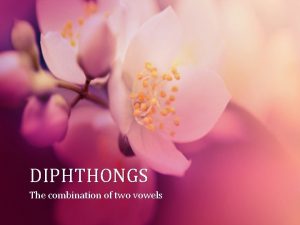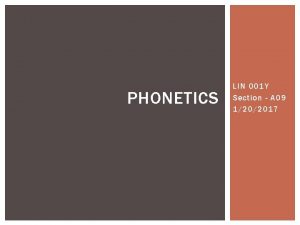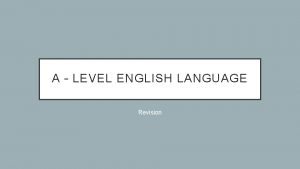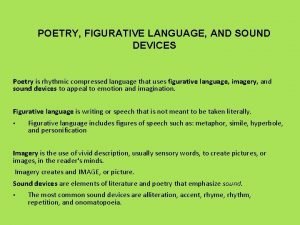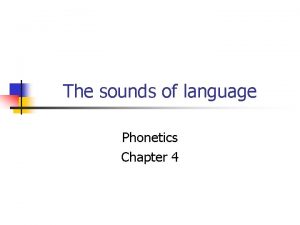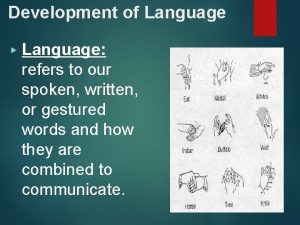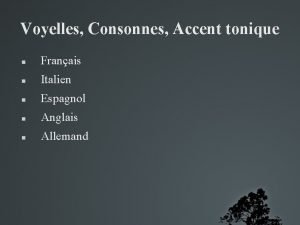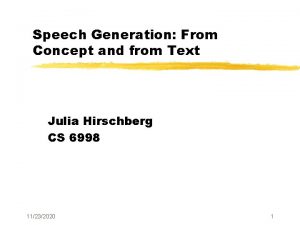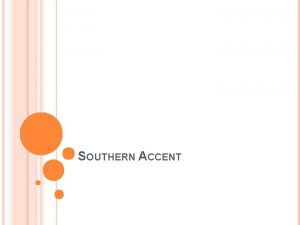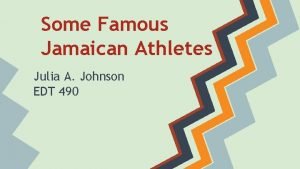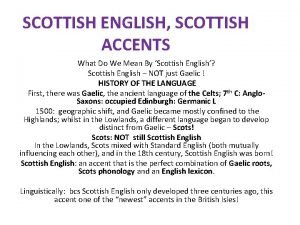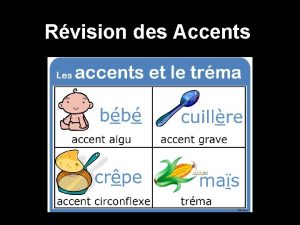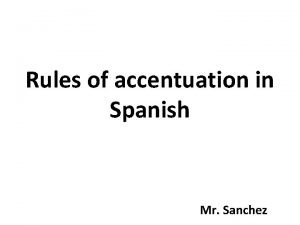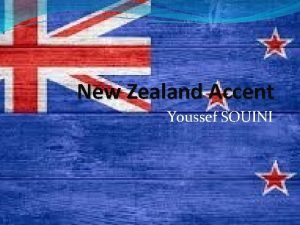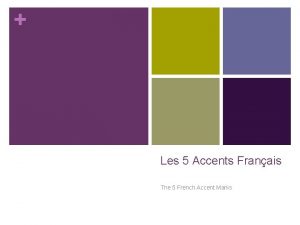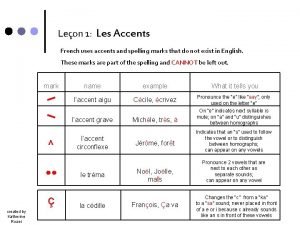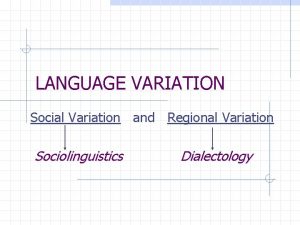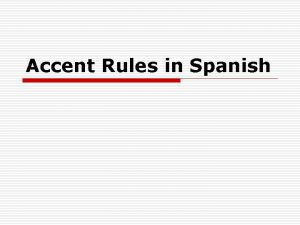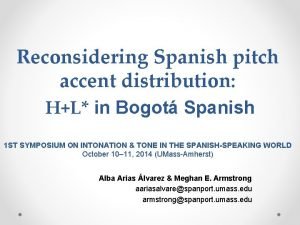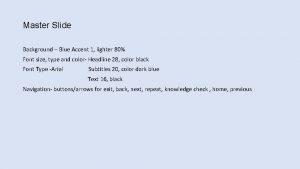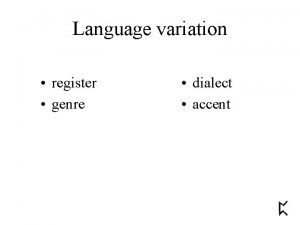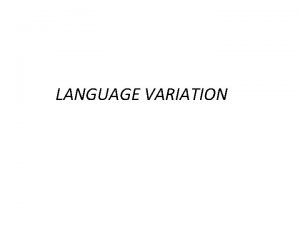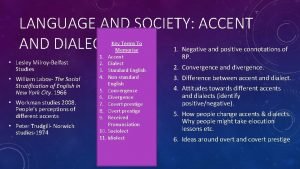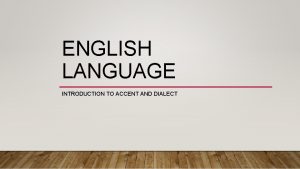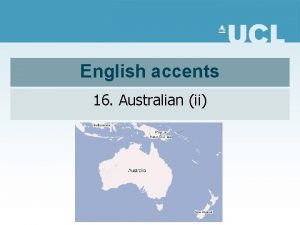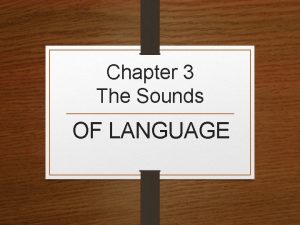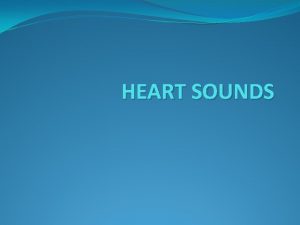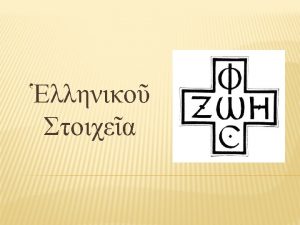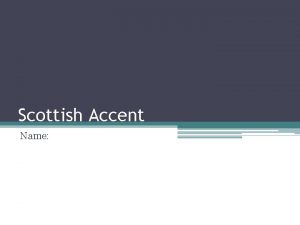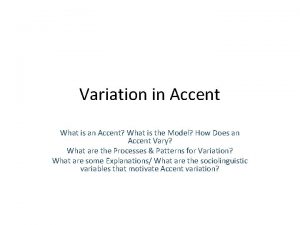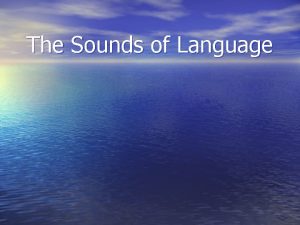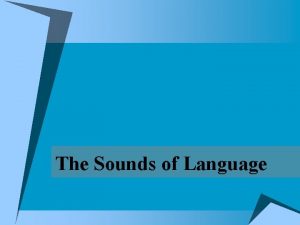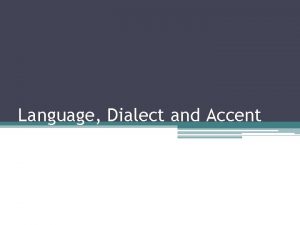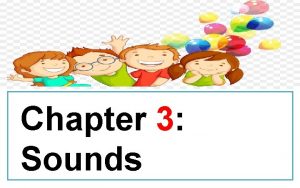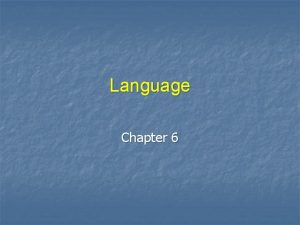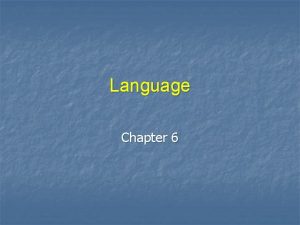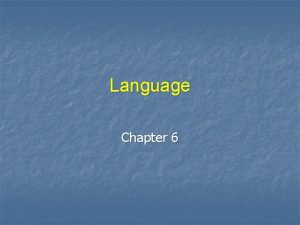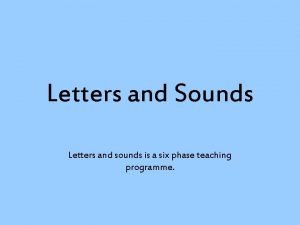Chapter 3 The Sounds OF LANGUAGE Accent vs










![Stops stop airflow, release [p] [b] [t] [d] [k] [g] Bilabial Alveolar Velar Voiceless Stops stop airflow, release [p] [b] [t] [d] [k] [g] Bilabial Alveolar Velar Voiceless](https://slidetodoc.com/presentation_image_h2/5681e066e5335fcff49785e9607c12b0/image-11.jpg)
![Fricatives restricted airflow [f] [v] [θ] [ð] [s] [z] [ʃ] [ʒ] [h] Labiod ental Fricatives restricted airflow [f] [v] [θ] [ð] [s] [z] [ʃ] [ʒ] [h] Labiod ental](https://slidetodoc.com/presentation_image_h2/5681e066e5335fcff49785e9607c12b0/image-12.jpg)
![Affricates stop + restricted airflow [tʃ] [dʒ] Palatal Voiceless Voiced Chip Jam • Produced Affricates stop + restricted airflow [tʃ] [dʒ] Palatal Voiceless Voiced Chip Jam • Produced](https://slidetodoc.com/presentation_image_h2/5681e066e5335fcff49785e9607c12b0/image-13.jpg)
![Nasals lowered velum, air through nose [m] [n] [ŋ] Bilabial Alveolar Velar Voiced Man Nasals lowered velum, air through nose [m] [n] [ŋ] Bilabial Alveolar Velar Voiced Man](https://slidetodoc.com/presentation_image_h2/5681e066e5335fcff49785e9607c12b0/image-14.jpg)
![Liquids air flows around sides of tongue [l] [ɹ] Alveolar Voiced Lad Red �The Liquids air flows around sides of tongue [l] [ɹ] Alveolar Voiced Lad Red �The](https://slidetodoc.com/presentation_image_h2/5681e066e5335fcff49785e9607c12b0/image-15.jpg)
![Glides tongue in motion, "semi-vowels”) [w] [j] [h] Bilabial Palatal Glottal Voiced Voiceless Wait Glides tongue in motion, "semi-vowels”) [w] [j] [h] Bilabial Palatal Glottal Voiced Voiceless Wait](https://slidetodoc.com/presentation_image_h2/5681e066e5335fcff49785e9607c12b0/image-16.jpg)
![Glottal Stop and the Flap Glottal stop: [ʔ] �Produced when the space between the Glottal Stop and the Flap Glottal stop: [ʔ] �Produced when the space between the](https://slidetodoc.com/presentation_image_h2/5681e066e5335fcff49785e9607c12b0/image-17.jpg)









![IPA: International Phonetic Alphabet IPA SYMBOL WORD EXAMPLE IPA TRANSCRIPTION [i] fee [fi] [I] IPA: International Phonetic Alphabet IPA SYMBOL WORD EXAMPLE IPA TRANSCRIPTION [i] fee [fi] [I]](https://slidetodoc.com/presentation_image_h2/5681e066e5335fcff49785e9607c12b0/image-27.jpg)
![IPA: International Phonetic Alphabet IPA SYMBOL WORD EXAMPLE IPA TRANSCRIPTION [p] spit [sp. It] IPA: International Phonetic Alphabet IPA SYMBOL WORD EXAMPLE IPA TRANSCRIPTION [p] spit [sp. It]](https://slidetodoc.com/presentation_image_h2/5681e066e5335fcff49785e9607c12b0/image-28.jpg)
![IPA: International Phonetic Alphabet IPA SYMBOL WORD EXAMPLE IPA TRANSCRIPTION [ θ ] theta IPA: International Phonetic Alphabet IPA SYMBOL WORD EXAMPLE IPA TRANSCRIPTION [ θ ] theta](https://slidetodoc.com/presentation_image_h2/5681e066e5335fcff49785e9607c12b0/image-29.jpg)



- Slides: 32

Chapter 3 The Sounds OF LANGUAGE

Accent vs. Dialect �Do you have an accent? �What is the difference between an accent and a dialect? • Accent: Manner of pronunciation, typically associated with a particular nation, locality, or social class. �Dialect: Manner of speech which differs in structure, grammar, pronunciation, and vocabulary Ø Different dialects are mutually comprehensible; different languages are not. http: //youtu. be/3 Ugpf. Sp 2 t 6 k

American Dialects http: //www. nytimes. com/interactive/2013/12/20/sunday-review/dialect-quiz-map. html

English is not spelled how it sounds �Heard looks like Beard but sounds like Bird �Dead looks like Bead but sounds like Bed �Meat looks like Great but sounds like Sweet �Moth looks like Mother but sounds like Cloth �Dear looks like Pear but sounds like Beer

Phonetics Auditory Phonetics - How sounds are made Acoustic Phonetics How sounds are transmitted (Decibel etc. ) Our Concern Auditory Phonetics How sounds are heard

Production of Speech Sounds Ø Voiced or Voiceless - Whether they make the vocal cords vibrate or not Ø Place of articulation - WHERE the sound is produced Ø Manner of articulation – HOW the sound is produced

Voiced and Voiceless Sounds Voiced Sounds Vocal folds are drawn together. As air passes through trachea, creates vibrating sounds: Ø All vowels and diphthongs are voiced: a, e, i, o, u, and y (as in ‘pity’) Ø Consonants: b, d, v, l, r, z, j, and th (as in ‘them’) Voiceless Sounds Vocal folds are spread apart. Air passes out without restriction: Ø Consonants like: p, t, k, s, sh, ch, th (as in ‘thing’)

Places of Articulation


Manner of Articulation �How a sound is made �Important for explaining how to make sounds �For example, [d] and [z] are made in the same place of articulation, the alveolar ridge, but they have different manners of articulation.
![Stops stop airflow release p b t d k g Bilabial Alveolar Velar Voiceless Stops stop airflow, release [p] [b] [t] [d] [k] [g] Bilabial Alveolar Velar Voiceless](https://slidetodoc.com/presentation_image_h2/5681e066e5335fcff49785e9607c12b0/image-11.jpg)
Stops stop airflow, release [p] [b] [t] [d] [k] [g] Bilabial Alveolar Velar Voiceless Voiced Pin Bin Tin Dig Camera Sing �Also called ‘plosives’ �Produced by a form of brief stopping of the airstream
![Fricatives restricted airflow f v θ ð s z ʃ ʒ h Labiod ental Fricatives restricted airflow [f] [v] [θ] [ð] [s] [z] [ʃ] [ʒ] [h] Labiod ental](https://slidetodoc.com/presentation_image_h2/5681e066e5335fcff49785e9607c12b0/image-12.jpg)
Fricatives restricted airflow [f] [v] [θ] [ð] [s] [z] [ʃ] [ʒ] [h] Labiod ental Labiode ntal Dental Alveolar Palatal Glottal Voicele ss Voiced Voiceles s voiced Voiceles s Voiced Voicele ss Safe Save Bathe Sink Zoom Shop Casual Who Produced by almost blocking the airstream (air pushes through a very narrow opening) �Fish begins and ends with fricatives [f] and [ʃ] �Those begins and ends with fricatives [ð ] and [z]
![Affricates stop restricted airflow tʃ dʒ Palatal Voiceless Voiced Chip Jam Produced Affricates stop + restricted airflow [tʃ] [dʒ] Palatal Voiceless Voiced Chip Jam • Produced](https://slidetodoc.com/presentation_image_h2/5681e066e5335fcff49785e9607c12b0/image-13.jpg)
Affricates stop + restricted airflow [tʃ] [dʒ] Palatal Voiceless Voiced Chip Jam • Produced by a combination of a brief stopping of airstream with an obstructed release, causing some friction • cheap and jeep have affricate sounds [tʃ] and [dʒ]
![Nasals lowered velum air through nose m n ŋ Bilabial Alveolar Velar Voiced Man Nasals lowered velum, air through nose [m] [n] [ŋ] Bilabial Alveolar Velar Voiced Man](https://slidetodoc.com/presentation_image_h2/5681e066e5335fcff49785e9607c12b0/image-14.jpg)
Nasals lowered velum, air through nose [m] [n] [ŋ] Bilabial Alveolar Velar Voiced Man Not Ring • Produced when the vellum is lowered and the airstream is allowed to flow out through the nose • morning, knitting and name begin and end with nasals
![Liquids air flows around sides of tongue l ɹ Alveolar Voiced Lad Red The Liquids air flows around sides of tongue [l] [ɹ] Alveolar Voiced Lad Red �The](https://slidetodoc.com/presentation_image_h2/5681e066e5335fcff49785e9607c12b0/image-15.jpg)
Liquids air flows around sides of tongue [l] [ɹ] Alveolar Voiced Lad Red �The [l] sound as in led is formed by letting the airstream flow around the sides of the tongue as the tip of the tongue makes contact with the middle of the alveolar ridge. �The [ɹ] sound as in red is formed with the tip of the tongue raised and curled back near the alveolar ridge.
![Glides tongue in motion semivowels w j h Bilabial Palatal Glottal Voiced Voiceless Wait Glides tongue in motion, "semi-vowels”) [w] [j] [h] Bilabial Palatal Glottal Voiced Voiceless Wait](https://slidetodoc.com/presentation_image_h2/5681e066e5335fcff49785e9607c12b0/image-16.jpg)
Glides tongue in motion, "semi-vowels”) [w] [j] [h] Bilabial Palatal Glottal Voiced Voiceless Wait Gem Hand �Produced with the tongue in motion or ‘gliding’ to or from the position of a vowel �They are sometimes called semi-vowels or approximants �we, wet, you, yes, hi and hello
![Glottal Stop and the Flap Glottal stop ʔ Produced when the space between the Glottal Stop and the Flap Glottal stop: [ʔ] �Produced when the space between the](https://slidetodoc.com/presentation_image_h2/5681e066e5335fcff49785e9607c12b0/image-17.jpg)
Glottal Stop and the Flap Glottal stop: [ʔ] �Produced when the space between the vocal cords (glottis) is closed completely (very briefly) and then released �Uh oh! [ʌ ʔ ow] The flap: [ɾ] �Butter or Manhattan

VOWELS Food/Boot Feed Fit Above (Schwa- Un- Book Note stressed syllable) Fade Above Fed Father Fought hot

Vowels: Diphthongs and Rcontrolled Sound made by combining two vowels, when the sound starts as one vowel sound and ends as another [aɪ] = fight [aʊ] = foul [eɪ] = fate [oʊ] = foe [ɔɪ] = foil [ɚ] = fighter (used in unstressed syllables) [ɝ] = first (used in stressed syllables) ex. girl, world, third, hurl, sure “sound of the angry dog”

Individual Variation • Do you pronounce these the same or differently? caught/cot

Yankee or Dixie? How much of each are you? • • • You (se) guys Car-a-mel Pajamas, like in Jam Route, like in Root Cot = caught Aunt = Ant • • • Y’all Car-ml Pajamas, like in Job Route, like in Rout Caught = [kawt] Aunt = *Ain’t

Phone The basic unit of phonetics is called a phone. Ø Any human speech sound is a phone. Ø Phones are often expressed by placing brackets around an IPA transcription, like [dæns] for the American pronunciation of dance.

Phonology Ø The study of systems and patterns of speech sounds in languages Ø The basic unit in phonology is the phoneme, which is any sound in language that distinguishes meaning (ex: in rat and mat, /r/ and /m/ are phonemes that change the meanings of the words) Ø Phonemes are often expressed by placing slashes around the IPA transcription: /b/

Phoneme • Any possible human speech • A contrastive unit in the sound in any language • The smallest identifiable unit in speech • Transcribed within brackets [b] [o] sound system of a specific language • A minimal unit that serves to distinguish between word meanings • Transcribed within slashes /b/ /o/

IPA: International Phonetic Alphabet • • • universal system to transcribe the sounds of speech used since 1888 represents each sound with a single symbols are enclosed in square brackets [ ] enables linguists to transcribe languages accurately

IPA: International Phonetic Alphabet Transcribe SOUNDS, not letters! Annie How many letters? How many sounds? [æni] The complete IPA is available as a word file on our class website.
![IPA International Phonetic Alphabet IPA SYMBOL WORD EXAMPLE IPA TRANSCRIPTION i fee fi I IPA: International Phonetic Alphabet IPA SYMBOL WORD EXAMPLE IPA TRANSCRIPTION [i] fee [fi] [I]](https://slidetodoc.com/presentation_image_h2/5681e066e5335fcff49785e9607c12b0/image-27.jpg)
IPA: International Phonetic Alphabet IPA SYMBOL WORD EXAMPLE IPA TRANSCRIPTION [i] fee [fi] [I] fit [f. It] [ej] fate [ f ej t] [ɛ] let [lɛt] [æ] bat [bæt] [u] boot [but] [ʊ] book [bʊk]
![IPA International Phonetic Alphabet IPA SYMBOL WORD EXAMPLE IPA TRANSCRIPTION p spit sp It IPA: International Phonetic Alphabet IPA SYMBOL WORD EXAMPLE IPA TRANSCRIPTION [p] spit [sp. It]](https://slidetodoc.com/presentation_image_h2/5681e066e5335fcff49785e9607c12b0/image-28.jpg)
IPA: International Phonetic Alphabet IPA SYMBOL WORD EXAMPLE IPA TRANSCRIPTION [p] spit [sp. It] [b] bib [ b I b] [t ] stuck [ s t ʌ k] [d] dip [d Ip ] [k] skip [sk. Ip] [g] get [ g ɛ t ]
![IPA International Phonetic Alphabet IPA SYMBOL WORD EXAMPLE IPA TRANSCRIPTION θ theta IPA: International Phonetic Alphabet IPA SYMBOL WORD EXAMPLE IPA TRANSCRIPTION [ θ ] theta](https://slidetodoc.com/presentation_image_h2/5681e066e5335fcff49785e9607c12b0/image-29.jpg)
IPA: International Phonetic Alphabet IPA SYMBOL WORD EXAMPLE IPA TRANSCRIPTION [ θ ] theta thick [θ I k] [ ð ] eth though [ə] schwa [ ɾ ] flap the [ðow] [ð ə] hitting [h I ɾ I ŋ] [ŋ] sang [sæŋ] [tʃ ] chip [ dʒ ] judge [ tʃ I p] [dʒ ʌ dʒ]

PHONETICS & PHONOLOGY

Phonetics • The general study of the characteristics of speech sounds - This includes whether sounds are voiced or voiceless sounds as well as their manner and place of articulation - The International Phonetic Alphabet (IPA) is used to help accurately describe sounds

Phonology • The study of systems and patterns of speech sounds in languages • The basic unit in phonology is the phoneme, which is any sound in language that distinguishes meaning (ex: in rat and mat, /r/ and /m/ are the phonemes which change the meanings of the words) • Phonemes are often expressed by placing slashes around the IPA transcription: /b/
 Closing and centering diphthongs
Closing and centering diphthongs Oral sounds and nasal sounds
Oral sounds and nasal sounds Early modern english verb conjugation
Early modern english verb conjugation Figurative language for sounds
Figurative language for sounds The sounds of language
The sounds of language Language refers to the
Language refers to the The sounds of language
The sounds of language L'accent tonique en italien
L'accent tonique en italien Julia garber accent
Julia garber accent What is a country accent
What is a country accent Julia garber accent
Julia garber accent Scots example
Scots example Aigu grave circonflexe tréma
Aigu grave circonflexe tréma Accentuation rules
Accentuation rules Sample accent paragraph
Sample accent paragraph Slidetodoc.com
Slidetodoc.com New jersey accent
New jersey accent Beats organized in a recurring accent pattern
Beats organized in a recurring accent pattern Greek syllables
Greek syllables E with accent
E with accent Leon accent
Leon accent Language variation
Language variation Exploring microsoft office 2013 volume 1
Exploring microsoft office 2013 volume 1 N accent
N accent Syllable divider
Syllable divider Cockney accent where from
Cockney accent where from Spanish pitch accent
Spanish pitch accent Blue accent 1 lighter 80
Blue accent 1 lighter 80 Dialect vs accent
Dialect vs accent What is regional variation in sociolinguistics
What is regional variation in sociolinguistics Language
Language Dialect vs accent
Dialect vs accent Nonrhotic
Nonrhotic
